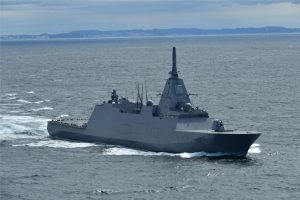Japan is striving to expedite its drastic defense buildup to deal with rising military threats posed by China, North Korea, and Russia.
On December 22, the cabinet of Japanese Prime Minister Kishida Fumio approved 7.95 trillion yen ($55.9 billion) in defense spending for fiscal year 2024, starting in April, amid what Tokyo calls “the most severe and complex security environment since the end of World War II.”
Including U.S. Forces realignment-related expenses allocated for mitigating impacts on local communities, the draft budget will rise by a whopping 16.5 percent, or $7.92 billion, from the current fiscal year. This marked another record figure for the tenth year in a row for Japan’s national defense budget.
The FY2024 budget plan, which is expected to be passed by the country’s bicameral legislature in the coming months, marks the second year of the new Defense Buildup Program, which outlines $302 billion in defense spending over the five-year period through FY2027.
The budget plan lists seven key pillars of “necessary efforts to drastically strengthen Japan’s defense capabilities.”
Those are: (1) “stand-off defense capabilities,” such as mass production of longer-range missiles; (2) “comprehensive air and missile defense capabilities” to respond to increasingly diverse and complex airborne threats, including missiles; (3) “unmanned asset defense capabilities,” such as the use of drones; (4) “cross-domain operational capabilities” in space, cyberspace, and electromagnetic domains; (5) “command and control and intelligence-related functions”; (6) “maneuvering and deployment capability” to send troops and supplies to the front line of a conflict; and (7) “sustainability and resiliency.”
As for the first pillar, the ministry secured about $5.16 billion to develop and produce a range of homegrown stand-off missiles to acquire counterstrike capabilities against enemy bases. That follows through on a decision made in December 2022 for Japan to pursue a long-range strike capability, as reflected in the new National Security Strategy.
Most notably, the Defense Ministry earmarked $675.7 million to acquire a land-based improved variant of the Mitsubishi Heavy Industries (MHI)-developed Type 12 surface-to-ship missile (SSM) for FY2024.
On December 15, Japan’s Defense Minister Kihara Minoru announced that the Japan Ground Self-Defense Force (JGSDF) will deploy the land-based upgraded Type 12 SSM starting in its fiscal year FY2025, a year earlier than originally planned.
Japan’s current stand-off missile capability is mainly focused on the upgraded Type 12 SSM, which is the core of Japan’s counterattack ability. Stand-off missiles allow a military to attack sites such as enemy missile bases from outside the enemy’s range.
On the second pillar, the Defense Ministry secured $8.77 billion for strengthening the nation’s Integrated Air and Missile Defense (IAMD), a system already adopted by the U.S. military, to address new aerial threats, including hypersonic weapons developed by China, North Korea, and Russia.
The ministry’s Acquisition, Technology, and Logistics Agency (ATLA) was allocated $513 million to push ahead with its next-generation fighter program in partnership with the United Kingdom and Italy. It plans to continue developing a basic design of the future fighter’s fuselage and the detailed engineering of its engines.
ATLA also secured $129 million to domestically develop a new medium-range air-to-air guided missile to be installed in the next-generation fighter, which is set to be the successor to the Japan Air Self-Defense Force (JASDF)’s F2 fighter jet.
The JASDF earmarked $787 million to buy eight more Lockheed Martin F-35A Lightning II joint strike fighters and $901 million to purchase seven more F-35B Lightning multirole fighter aircraft.
The Japan Maritime Self-Defense Force (JMSDF) was allocated large amounts of funds totaling $2.62 billion to build two Aegis system-equipped vessels, which are alternatives to Japan’s now-scrapped plan for a land-based Aegis Ashore ballistic missile defense system. The ministry expects the total construction cost for each vessel to reach $2.75 billion.
The JMSDF also secured $1.22 billion to build two new multirole frigates, called “New FFM,” in Tokyo.
The Defense Ministry said it will acquire a total of 12 New FFMs that will succeed the Mogami-class FFM for the JMSDF. The New FFM has a standard displacement of 4,800 tons, while the Mogami class has a standard displacement of 3,900 tons.
Although the new warship class will be heavier and larger than the Mogami class, defense officials said the New FFM’s crew complement will be only 90, the same as that of the Mogami class.
The JMSDF had originally planned to build a total of 22 Mogami-class frigates as Tokyo ramps up efforts to strengthen the country’s naval forces.
However, it has decided to now procure a total of only 12 such frigates until 2023, with plans to construct a new class of 12 warships from 2024. The new frigates will essentially be improved Mogami-class ships.
The Defense Ministry said the new-class FFM will be fitted with longer-range missiles, enhanced anti-submarine capabilities, and improved capabilities for various maritime operations.
The JMSDF also earmarked $298 million to continue modifying its two Izumo-class helicopter carriers – JS Izumo and JS Kaga – into aircraft carriers capable of enabling Lockheed Martin F-35B fighter operations.
The JMSDF said both ships will complete all necessary upgrades to become light aircraft carriers operating F-35B fighters in fiscal year 2027.
Meanwhile, the Japan Ground Self-Defense Force (JGSDF) strives to strengthen security efforts in response to emergency contingencies in areas surrounding Japan, particularly in the Nansei Islands, with China in mind.
It was allocated $121.6 million to procure three maneuverable boats during the next fiscal year in an effort to secure capabilities for swift and reliable transportation of necessary units to defeat an invasion of Japan’s southwestern islands. The Defense Ministry said the boats will be 35 meters long.
Officials at the ministry stressed at a press briefing on December 21 that despite the rapid depreciation of the yen and rising prices, there has been no reduction in the number of major weapons and equipment for FY2024, based on the Defense Buildup Program, which was drawn up in December 2022.

































